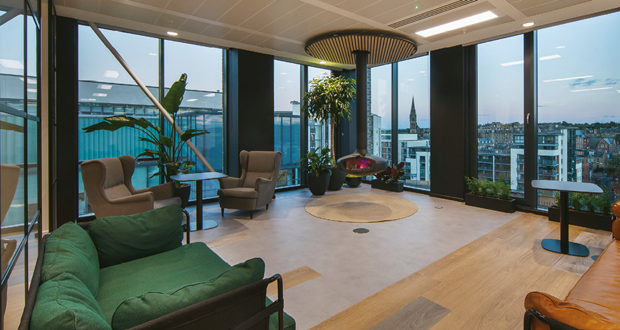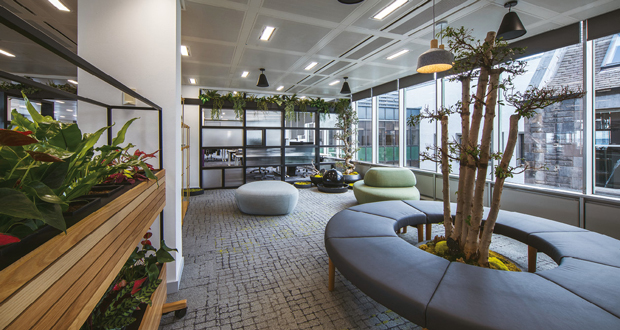A DESIRE FOR CONNECTION
Our research highlights that two of the primary reasons hybrid workers will visit the office is for face-to-face collaboration and to socialise with colleagues . This means workplace design has to incorporate spaces that promote and encourage social experiences. This desire for connection is about friendships with colleagues (statistics show that having a best friend at work makes it more enjoyable , plus those with a best friend at work are twice as likely to be engaged in their jobs and have a greater sense of wellbeing ) as well as feeling connected to the company – both of which have to ‘last’ until the next time they visit. Humans are inherently social creatures and spending time with friends releases powerful endorphins, which make us feel good. A workplace that delivers connection will aid wellbeing.
SENSE OF BELONGING
Building on our desire to feel connected, people also want to belong. Creating flexible spaces that bring teams and even workforces together can unite people in common goals, connect them with the brand and corporate culture and make them feel part of a team. Spaces such as office cafes, meeting suites and what we call ‘town hall’ spaces, can provide the facility for large company gatherings to share news, offer support and give praise.
LIGHT AND AIRY
Access to natural light is the number one attribute employees want in their office environment. It’s also linked with greater levels of staff engagement and productivity so in design terms, this means locating work settings near to natural light sources. Where the perimeter of a floorplate was typically used for meeting rooms or senior personnel’s offices, it’s now used to host a variety of work settings so that employees benefit from the light and it’s able to penetrate further into the floorplate. It may sound small, but access to natural light offers equitable experiences.
In a similar vein, we must consider access to fresh air. Poor ventilation leads to fatigue, poor cognitive function and ill health. As well as considering improved natural and mechanical ventilation, greater access to fresh air with opening windows, access to outdoor space and planting can all help to improve air quality, and therefore the employee experience.
CONNECTED TO NATURE
Greater access to nature and the great outdoors has been proven to improve air quality, stimulate the brain, improve engagement and make employees happier and healthier. So, in design terms, a workplace should consider how it can incorporate biophilia. In practice, this might involve using plants to help zone spaces, providing access to a communal garden or perhaps even sacrificing carparking to create an outdoor space, using nature inspired colours, materials and textures, such as wood and stone. This could also include providing showers for those choosing to cycle to work, or a bike share scheme to promote activity during the day. Balance is achieved by making sure time indoors isn’t time without nature.
DEDICATED SPACES
While flexible spaces can support many aspects of wellbeing, the more sensitive aspects of wellness require careful thought from a design point of view. For an employer offering on-site counselling to help employees’ mental health for example, these spaces need to be private, comfortable, discreetly located and bookable. Similar thought and attention should be given to accommodate religious needs (adequate space for prayer mats and quiet reflection), those breastfeeding (comfortable chairs, fridges for storing milk) and people managing other health conditions.
RELAX AND REJUVENATE
We all work at different paces, in different ways and at different times. Offering spaces for employees to rest and recharge is part of the wellness picture. Those spaces might be cafes, a shared kitchen, outdoor gardens, quiet pods with complete sound privacy or a well-positioned sofa that maximises views outside. With offices comprising significantly less desking post-COVID (now 36 per cent of a floorplate instead of 50 per cent ), there is more opportunity to curate moments of positive wellbeing.
SUSTAINABILITY
Employees increasingly want their employers’ environmental values and actions to align with their own social conscience. Ensuring that buildings and the workplaces they contain are sustainable can help to foster wellbeing by making employees comfortable in their choices and the actions of the business. Newer initiatives such as SKA (a RICS benchmark to evaluate office fit-out projects against sustainability good practice) and The Well Building Standard (for measuring, certifying and monitoring aspects of the built environment that impact health and wellbeing), are increasingly being recognised by the general public as people want greater assurances about their own wellbeing and that of the planet.
Organisations of all shapes and sizes are leading the revolution by taking care of employees’ holistic health and wellness. They’re doing this by knowing how to spot signs of employee burnout, establishing volunteer Mental Health First Aiders and Wellbeing Ambassadors, improving staff inclusion and social activities, updating Diversity, Inclusion Belonging and Equity (DIBE) strategies and running wellness programmes that span nutrition, sleep, fitness, finance and more.
But crucially, these organisations are also reinventing their workplaces. They know that the workplace, as an organisation’s home, has to be a beacon of wellness. In doing so, it will help attract and retain the brightest and best talent and create loyal, productive and engaged workforces.
Marrying the needs of your people with those of your organisation is a balancing act. But when individual and collective wellness is so closely linked with commercial profitability, as well as operational resilience and agility, it’s a balance worth finding. For facilities professionals involved in shaping workplace strategy and operating buildings daily, wellbeing cannot be ignored. As the saying goes, health is wealth, and it must be designed into the fabric of buildings and the workspaces they comprise.
FURTHER INFORMATION
Claremont’s latest Annual Insight Report (issue 6) draws on the research of more than 9,000 employees across the UK over the last 18 months. You can access your copy of Balanced Workplaces here: www.claremontgi.com/balanced-workplaces/






